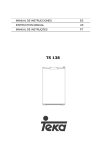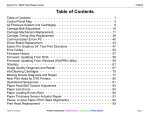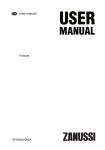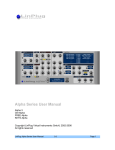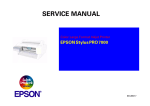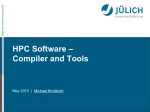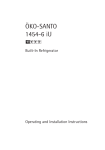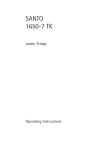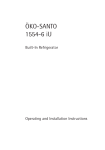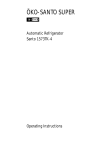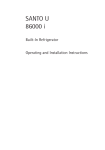Download Zanussi Freezer Instruction manual
Transcript
INSTRUCTION MANUAL MODEL:ZRG31SW Downloaded from Fridge-Manual.com Manuals Dear customer, Before placing your new refrigerator/freezer into operation please read these operating instructions carefully. They contain important information for safe use, for installation and for care of the appliance. Please keep these operating instructions for future reference. Pass them on to possible new owners of the appliance. Notes which are important for your safety or for the proper functioning of the appliance are stressed with a warning triangle and/ or with signal words (Warning!, Caution!, Important!! ). Please observe the following carefully. Supplementary information regarding operation and practical applications of the appliance appear after this symbol. Tips and notes concerning economical and environmentally sound use of the appliance are marked with the cloverleaf. The operating instructions contain instructions for the correction of possible malfunctions by the user in the section “Trouble shooting”. If these instructions should not be sufficient, contact your local Service Force Centre. Printed on paper manufactured with environmentally sound processes he who thinks ecologically acts accordingly... Downloaded from Fridge-Manual.com Manuals Contents 4.Important Safety Instruction 6.Remove transport packaging 7.Installation 7.Installation Location 7.Your refrigerator needs air 8.Reversing the door 9.Changing over the freezer compartment door 10.Prior to Initial Start up 10.Description of the appliance 10.View of the appliance 10.Starting up and temperature regulation 11.Interior Accessories 11.Storage shelves/wire trays 12.Correct storage 12.Freezing and storing frozen food 13.Preparation of Ice Cubes 14.Defrosting 14.The fridge defrosts automatically 14.Defrosting the freezer compartment 15.Switching off the appliance 15.Cleaning and Care 16.Energy Saving Tips 16.Trouble shooting 16.Correcting Malfunctions 18.Changing the light bulb 18.Noises during Operation 19.Electrical connection Downloaded from Fridge-Manual.com Manuals Important Safety Instructions These warnings are provided in the interests of your safety. Ensure you fully understand them before installing or using the appliance. Your safety is of paramount importance. If you are unsure about the meaning of these warnings contact the Customer Care Department for assistance. Intended use The refrigerator is intended for use in the home. It is suitable for the cooling, freezing and storing of frozen food, as well as for making ice. If the appliance is used for purposes other than those intended or used incorrectly, no liability can be accepted by the manufacturer for any damage that may be caused. Alterations or changes to the refrigerator are not permitted for reasons of safety. If you use the refrigerator in a commercial application or for purposes other than the cooling, freezing or frozen storage of foods, the manufacturer accepts no liability for any damages which may occur. Prior to initial start-up Ensure that the appliance does not stand on the electrical supply cable. Important: If the supply cable is damaged, it must be replaced by authorized service or qualified personnel using a special cable of the same type. Check the appliance for transport damage. Under no circumstance should a damaged appliance be plugged in! In the event of damage, please contact your supplier. WARNING-Keep ventilation openings, in the appliance enclosure or in the build-in structure, clear of obstruction. WARNING-Do not use mechanical devices or other means to accelerate the defrosting process, other than those recommended by the manufacturer. WARNING-Do not damage the refrigerant circuit. WARNING- This appliance is not intended for use by young children or infirm persons unless they have been adequately supervised by a responsible person to ensure that they can use the appliance safely . Young children should be supervised to ensure that they do not play with the appliance. Downloaded from Fridge-Manual.com Manuals 4 WARNING—This appliance is not intended for use by persons (including children) with reduced physical, sensory or mental capabilities, or lack of experience and knowledge, unless they have been given supervision or instruction concerning use of the appliance by a person responsible for their safety. Children should be supervised to ensure that they do not play with the appliance. WARNING—When disposing of the appliance do so only at an authorized waste disposal centre. Do not expose to flame. WARNING—if the supply cord is damaged, it must be replaced by a special cord or assembly available from the manufacturer or its service agent. Refrigerant Refrigerant gas is contained within the refrigerant circuit of the appliance. Ensure that none of the components of the refrigerant circuit becomes damaged during transportation and installation. During transportation and installation of the appliance, be certain that none of the components of the refrigerant circuit become damaged. If the refrigerant circuit should become damaged: avoid open flames and sources of ignition; thoroughly ventilate the room in which the appliance is situated. Safety of children Packaging (e.g. wraps, polystyrene) can be dangerous for children. There is a risk of suffocation! Keep packaging material away from children! Please make old appliances unusable prior to disposal. Pull out the mains plug, cut off the mains cable, break or remove spring or bolt catches, if fitted. By doing this you ensure that children cannot lock themselves in the appliance when playing (there is risk of suffocation!) or get themselves into other dangerous situations. Often children cannot recognize the hazards present in household appliances. It is therefore important that you ensure adequate supervision and never let children play with the appliance! Downloaded from Fridge-Manual.com Manuals 5 Daily Operation Containers with flammable gases or liquids can leak at low temperatures. There is a risk of an explosion! Do not store any containers with flammable materials such as spray cans, fire extinguisher refill cartridges etc in the refrigerator and/or freezer. Bottles and cans must not be placed in the freezer compartment. They can burst when the contents freeze, high carbonate content drinks can even explode! Never store lemonade, juices, beer, wine, sparkling wine etc. in the freezer compartment. Do not put ice cream or ice cubes in the mouth immediately after removal from the freezer compartment. Very cold ice can freeze to the lips or tongue and cause injury. Do not touch frozen food with wet hands. Your hands could freeze to the food. Do not operate any electrical appliances in the refrigerator and/or freezer (e.g. electric ice cream makers, mixers etc.). Before cleaning the appliance, always switch off the appliance and unplug it, or pull the house fuse or switch off the circuit breaker. When unplugging always pull the plug from the mains socket, do not pull on the cable. In case of malfunction If a malfunction occurs on the appliance, please look first in the @Trouble shooting. @ section of these instructions. If the information given there does not help, please do not perform any further repairs yourself. Under no circumstance should you attempt to repair the appliance yourself. Repairs carried out by inexperienced persons may cause injury or serious malfunctioning. Contact your local Service Force Centre. Remove transport packaging The appliance and the interior fittings are protected for transport. Pull off the adhesive tape on the left and right side of the door. You can remove any remnants of adhesive using white spirit. Remove all adhesive tape and packing pieces from the interior of the appliance. Downloaded from Fridge-Manual.com Manuals 6 Installation Installation Location The appliance should be set up in a well-ventilated, dry room. Energy use and efficient performance of the appliance is affected by the ambient temperature. The appliance should therefore not be exposed to direct sunlight; Do not be installed next to radiators, cookers or other sources of heat; only be installed at a location whose ambient temperature corresponds to the climate classification, for which the appliance is designed. The climate classification can be found on the serial plate, which is located at the left on the inside of the appliance. The appliance must be positioned so that the plug is accessible. The following table shows which ambient temperature is correct for each climate classification: Climate classification For an ambient temperature SN +10 to +32℃ N +16 to +32℃ ST +16 to +38℃ T +16 to +43℃ If the refrigeration appliance is installed next to another refrigerator or freezer a clearance of 5 cm at the sides is required, in order to prevent the formation of condensation on the outside of the appliance. Your refrigerator needs air . For correct operation this appliance must be located in a dry atmosphere, away from heat sources, e.g. cookers, radiators, boilers and direct sunlight. You should also ensure that air can circulate freely around the back and the top of the cabinet. There should be 100mm between the top of the cabinet and any overhanging kitchen furniture. Alternatively allow 50mm between the top of the cabinet and any overhanging kitchen furniture and a gap of 25mm on either side of the appliance. Downloaded from Fridge-Manual.com Manuals 7 Reversing the door This refrigerator has the capability of either opening the door from the left or right side. This unit is delivered to you with the door opening from the left side. Should you desire to reverse the opening direction, please follow these instructions. NOTE: All parts removed must be saved to do the reinstallation of the door. Reversal Refrigerator Door 1.Remove the screw nails (11). 2. Keep the door open, raise the end of the top cover, push it(10) frontad and take it off from the block(9) of the top cover, then move the bottom block(8). 3.Remove the two screws blot (6) that connect the upper hinge (5) on the right side of the cabinet top. 4.Carefully lift the door and place it on a padded surface to prevent scratching. 5.Remove the plug (7) and transfer it to the uncovered hole on the right side of the unit. Be sure to press the button firmly into the hole. 6.Remove the two screws(6) that hold the lower hinge (2) on the right side of the unit. 7.Remove the screw-type leveling front leg (4) and transfer it to the right side as shown in the adjacent figure. 8.Set the door into it's new place making sure the pin enters the bushing at the lower frame section (hole). 9.Secure the upper hinge (5) previously removed in step 3 on the left side of the unit. Make sure the pin enters the bushing on the upper frame section (hole). 10.Loosely secure the lower left hinge (2) and do not tighten the bolts until the door is in the closed position and leveled. 11.Insert the plug (7) on the uncovered holes (right side). 12.Fix the decoration block(8)in the right of the top cover plate(10). 13. Keep the door open, raise the end of the top cover, pull it(10) backwards to hitch the block(9). 14.After the assembly of the top cover, close the door, fix the top cover(10 ) with the screw(11). 1 11 2 10 7 3 9 4 8 5 6 7 8 9 10 11 Downloaded from Fridge-Manual.com Manuals 8 Screw Low Hinge Upper Hinge Adjustable Low Foot Adjustable High Foot Screw Bolt Plug Decoration Block The block of the top cover Top Cover Plate Screw nail Changing over the freezer compartment door Open the freezer compartment door a little way. Using a small screwdriver, press the spring in the opening of the lower door bearing slightly upwards and take the door bearing out complete with the door. Position the covering cap (M) on the opposite side. Turn the freezer compartment door through 180 and fit the lower door bearing into the lower bearing cavity of the freezer compartment door. Lift the freezer compartment door a little way upwards, fit it into the upper door bearing, and at the same time insert the lower door bearing into the square hole. Small upward and downward adjustments of the freezer compartment door will make fitting easier. Downloaded from Fridge-Manual.com Manuals 9 Prior to Initial Start-up Please clean the appliance interior and all accessories prior to initial start-up (see section: cleaning and Care). Description of the appliance View of the appliance 1.Butter/cheese compartments and egg storage insert 2.Door storage compartment 3.Bottle shelf 4.Vegetable drawers 5.Storage shelves 6.Temperature regulator 7.Freezer compartment 8.Rating plate Starting up and temperature regulation Insert the plug of the connection lead into the plug socket with protective earth contact. When the refrigerator compartment door is opened, the internal lighting is switched on. The temperature selector knob is located on the RH side of the refrigerator compartment. Setting “0”means: Off. Turning clockwise in direction “1” Refrigerating unit on, the latter then operating automatically. Setting” 1”meants: Highest temperature, warmest setting. Setting “7”(end-stop) means: Lowest temperature, coldest setting. Downloaded from Fridge-Manual.com Manuals 10 The temperatures in the refrigerator compartment and freezer compartment cannot be independently regulated. At a low ambient temperature of around 16℃, setting'1' should be selected. At ambient temperatures of around 25℃ , select setting'2' . If you require a lower temperature, select setting '3'or'4'. On this setting, you can be sure the fresh food will be reliably frozen and that a storage temperature of –12℃ will be maintained in the freezer compartment. If you want the freeze fresh food rapidly, select setting '7',ensuring that the temperature in the refrigerator compartment does not drop below 0℃. You should also promptly reset the temperature regulator to setting '3' or '4'. Important! High ambient temperatures (e.g. on hot summer days) and a cold setting on the temperature regulator (position'6' to '7') can cause the compressor to run continuously. Reason: when the ambient temperature is high, the compressor mustrun continuously to maintain the low temperature in the appliance. The fridge will not be able to defrost since automatic defrosting of the fridge is only possible when the compressor is not running (see also 'Defrosting' section). The result is the build up of a thick layer of frost on the fridge rear wall. If this happens, turn the temperature regulator back to a warmer setting (position '3'to '4'). At this setting the compressor will be switched on and off as usual and automatic defrosting recommenced. Interior Accessories Storage shelves/wire trays Various glass or plastic storage shelves and wire trays are included with your appliance- different models have different combinations. You should always slide one of the full size glass storage shelves into the lowest set of guides, above the fruit and vegetable containers, and keep it in this position. The height of the storage shelves can be adjusted: To do this pull the storage shelf forward until it can be swivelled upwards or downwards and removed. Downloaded from Fridge-Manual.com Manuals 11 Please do the same in reverse to insert the shelf at a different height. Correct storage 1.Butter and cheese 2.preserves 3.Drinks 4.Cheese storage, fruit, and vegetables 5.Meat, salami, cold cuts, dairy produce 6.Ready meals, pastries, preserves 7.Frozen food storage/freezing food Tip: Food in the fridge should always be covered or packaged, to prevent drying and tainting of other food. The following are suited for packaging: -Polyethylene airtight bags and wraps; -Plastic containers with lids; -Special plastic covers with elastic; -aluminium foil. Freezing and storing frozen food The freezer compartment is for freezing and storing food. Important! The temperature in the freezer compartment must be –12℃ or colder before freezing food or storing food already frozen. Do not freeze too large a quantity at any one time (max. 1 kg per 24 hrs). The quality of the food is best preserved when it is frozen right through to the core as quickly as possible. Allow warm food to cool down before freezing. The warmth will cause increased ice formation and increase the power consumption. Please note the maximum storage times specified by the manufacturer. Thawed foods which have not been processed further (cooked into meals) may not under any circumstances be frozen a second time. Containers with flammable gases or liquids can leak at low temperatures. There is a risk of an explosion! Do not store any containers with flammable materials such as spray cans, fire extinguisher refill cartridges etc in the freezer compartment. Downloaded from Fridge-Manual.com Manuals 12 Bottles and cans must not be placed in the freezer. They can burst when the contents freeze, high carbonate content drinks can even explode! Never store lemonade, juices, beer, wine, sparkling wine etc. in the freezer compartment. All foods must be packed air tight prior to freezing, so that they do not dry out or lose their flavour, and so that no flavour contamination of other frozen goods occurs. Caution! Do not touch frozen food with wet hands. Your hands could stick to the food and cause skin abrasions. Lay the packaged food on the floor of the freezer compartment. Unfrozen food must not touch items already frozen, otherwise the frozen food could begin to defrost. Tips: The following are suited for the packaging of frozen goods: freezer bags and polyethylene wraps; special cans for frozen goods; extra-thick aluminium foil. The followings are suitable for sealing bags and wrap: plastic clips, rubber bands or tape. Smooth the air out of the bag before sealing; air makes it easier for the frozen food to dry out. Make flat packages, because these freeze more quickly. Do not fill cans for frozen goods to the brim with liquid or paste-like goods, because liquids expand during freezing. Preparation of Ice Cubes Fill the ice cube tray 3/4 full with cold water, place it in the freezer compartment and leave to freeze. To loosen the frozen cubes, either bend the ice cube tray or hold it under running water for a few seconds. Important! Never try to free an ice tray that is frozen to the freezer compartment using pointed or sharp edged objects, since you may damage the refrigerating circuit. Use the plastic scraper. Downloaded from Fridge-Manual.com Manuals 13 Defrosting The fridge defrosts automatically The rear wall of the fridge covers with frost when the compressor is running, and defrosts when the compressor is off. The water from the thawing frost evaporates by itself. Defrosting the freezer compartment During use and when the freezer compartment door is opened, moisture is deposited in the freezer compartment as frost. Remove this frost from time to time with the soft plastic scraper. Under no circumstances, use hard or pointed objects to remove frost. The freezer compartment should always be defrosted when the layer of frost has reached a thickness of approx. 4 millimetres; however at least once a year. A good time for defrosting is when the appliance is empty or contains only little food. Warning! Do not use electrical heating appliances or any other mechanical or artificial devices to speed up the defrosting process, with the exception of those recommended in these operating instructions. Do not use defrosting sprays, they can be hazardous to your health and/or contain substances that damage plastics. Caution! Do not touch frozen food with wet hands. Your hands could stick to the food and cause skin abrasions. Remove frozen food, wrap it in several layers of newspaper and store it, covered, in a cool place. Switch off the appliance and unplug it, or pull the fuse or switch off the circuit breaker. Tip: You can speed up the defrosting water in the freezer compartment and closing the doors. Remove pieces of ice that have fallen before they completely defrost. After defrosting, thoroughly clean the freezer compartment (see “Cleaning and Care” section). Downloaded from Fridge-Manual.com Manuals 14 Switching off the appliance To switch off the appliance, turn the temperature regulator to position “0”. If the appliance is not going to be used for an extended period: Remove all refrigerated packages. Switch off the appliance by turning the temperature regulator to position “0”. Remove the mains plug or switch off or turn out the circuit breaker or fuse. Clean thoroughly (see section “cleaning and Care”). Leave the door open to avoid the build up of odour. Cleaning and Care For hygienic reasons the appliance interior, including interior accessories, should be cleaned regularly. Warning! The appliance may not be connected to the mains during cleaning. Danger of electrical shock! Before cleaning switch the appliance off and remove the plug from the mains, or switch off or turn out the circuit breaker or fuse. Never clean the appliance with a steam cleaner. Moisture could accumulate in electrical components, danger of electrical shock! Hot vapour can lead to the damage of plastic parts. The appliance must be dry before it is placed back into service. Important! Ethereal oils and organic solvents can attack plastic parts, e.g. lemon juice or the juice from orange peel; butyric acid; cleansers which contain acetic acid. Do not allow such substances to come into contact with appliance parts. Do not use any abrasive cleansers. Remove frozen food and the food from the refrigerator. Wrap frozen food in several layers of newspaper. Store it in a cool place, well covered. Defrost the freezer compartment prior to cleaning (see @Defrosting@ section). Switch the appliance off and remove the plug from the mains, or switch off or turn out the circuit breaker or fuse. Clean the appliance and the interior accessories with a cloth and lukewarm water. Commercially available dish washing detergents may also be used. Downloaded from Fridge-Manual.com Manuals 15 After cleaning wipe with fresh water and rub dry. Accumulation of dust at the condenser increases energy consumption. For this reason carefully clean the condenser at the back of the appliance once a year with a soft brush or a vacuum cleaner. Check the water drain hole on the rear wall of the fridge. After everything is dry place appliance back into service. Energy Saving Tips Do not install the appliance near cookers, radiators or other sources of warmth. High ambient temperatures cause longer, more frequent operation of the compressor. Ensure sufficient air circulation and exhaust at the appliance base and at the back wall of the appliance. Never cover air vent openings. Do not place warm foods into the appliance. Allow warm foods to cool first. Only leave door open as long as necessary. Do not set temperature any colder than necessary. Put frozen food in the fridge to defrost. The cold in the frozen food will then be used to cool the fridge. Always keep the heat emitting condenser, the metal grille on the rear wall of your appliance clean. Trouble shooting Correcting Malfunctions Spare parts: The following spare parts can be ordered from your local AEG Service Force Centre. You can fit these yourself without any special skill ortraining, e.g.: butter/cheese compartment, egg holders, door racks, fruit and vegetable drawers, storage racks Downloaded from Fridge-Manual.com Manuals 16 A malfunction may be caused by only a minor fault that you can rectify yourself using the following instructions. Do not perform any other work on the appliance if the following information does not provide assistance in your specific case. Important! Repairs to refrigerators/freezers may only be performed by competent service engineers. Improper repairs can give rise to significant hazards for the user. If your appliance needs repairing, please contact your specialist dealer or your local Service Force Centre. Downloaded from Fridge-Manual.com Manuals 17 Changing the light bulb Warning! There is a risk of electric shocks! Before changing the light bulb, switch off the appliance and unplug it, or pull the fuse or the circuit breaker. Light bulb data:220~240 V, max. 15 W To switch off the appliance, turn the temperature regulator to position “0”. Unplug the mains plug. To change the light bulb, undo the screw. Press the light bulb cover as shown and slide it backwards. Change the defective light bulb. Refit the light bulb cover and the screw. Put the refrigerator back into operation. Noises during Operation The following noises are characteristic of refrigeration appliances: Clicks Whenever the compressor switches on or off, a click can be heard. Humming As soon as the compressor is in operation, you can hear it humming. Bubbling/ When refrigerant flows into thin tubes, you can hear Splashing bubbling or splashing noises. Even after the compressor has been switched off, this noise can be heard for a short time. Downloaded from Fridge-Manual.com Manuals 18 Electrical connection Caution! Any electrical work required to install this appliance should be carried out by a qualified electrician or competent person. Warning! This appliance must be earthed. The manufacture declines any liability should these safety measures not be observed. 2 3 5 4 Important! The wires in the mains lead are colored in accordance with the following code 1 Green and Yellow: Earth 3 Brown: Live Neutral 5 Blue: As the colours of the wires in the mains lead of this appliance may not correspond with the coloured markings identifying the terminals in your plug, proceed as follows: 1. Connect the wire coloured green and yellow to the terminal marked either with the letter “E” or by the earth symbol or coloured green and yellow. 2. Connect the wire coloured blue to the termi-nal either marked with the letter “N” or col-oured black. 3. Connect the wire coloured brown to the ter-minal either marked with the “L” or colour-ed red. 4. Check that no cut, or stray strands of wire is present and the cord clamp 4 is secure over the outer sheath. 5. Make sure the electricity supply voltage is the same as that indicated on the appliance rating plate. 6. Switch on the appliance. The appliance is supplied with a 13 amp plug fitted 2 . In the event of having to change the fuse in the plug supplied, a 13 amp ASTA approved (BS 1362) fuse must be used. Warning! A cut off plug inserted into a 13 amp socket is a serious safety Downloaded from Fridge-Manual.com Manuals 19



















